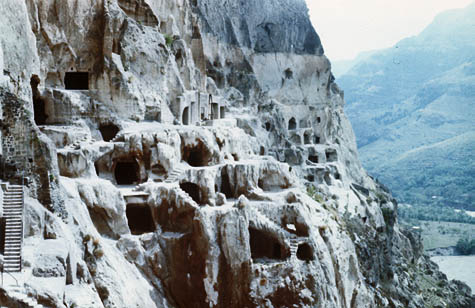 [Image: The Georgian cave monastery of Vardzia, via Wikipedia].
[Image: The Georgian cave monastery of Vardzia, via Wikipedia].
Vardzia is a ruined honeycomb of arched passageways and artificially enlarged caves on a steep mountainside in Georgia. It is on a “tentative list” for UNESCO World Heritage status.
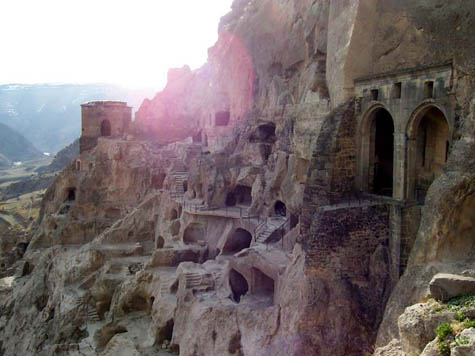 [Image: Vardzia, via Wikipedia].
[Image: Vardzia, via Wikipedia].
Quoting from Wikipedia:
The monastery was constructed as protection from the Mongols, and consisted of over six thousand apartments in a thirteen-story complex. The city included a church, a throne room, and a complex irrigation system watering terraced farmlands. The only access to the complex was through some well hidden tunnels near the Mtkvari river.
Nearby are the ruins of another cave monastery, called Vanis Kvabebi.
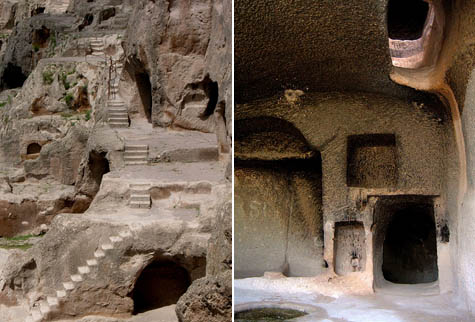 [Images: Vardzia, via Wikipedia].
[Images: Vardzia, via Wikipedia].
In the formal application sent to UNESCO for consideration of the site, we read that the architecture of this region can be seen as spatially punctuating the landscape, supplying moments of almost grammatical emphasis:
Fortresses and churches erected on high mountains and hills are perceived as distinguished vertical accents in such a horizontally developed setting. They terminate and emphasise natural verticals, being in perfect harmony with the latter. They introduce great emotional impulse imparting specific grandeur to the whole environment. The same artistic affect is created by rock-cut monasteries and villages arranged in several tiers on high rocky mountain slopes.
Originally constructed in the 12th century—in a region inhabited by humans since at least neolithic times—and very much resembling one of the cave-cities of Cappadocia, Vardzia is a spatially fantastic site (and, I’d assume, a videogame level waiting to happen).
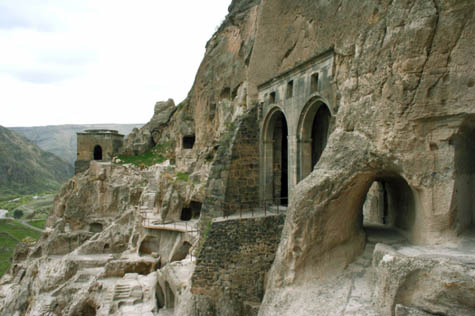 [Images: Vardzia, via Wikipedia].
[Images: Vardzia, via Wikipedia].
It is also located in one of the most geologically interesting places on earth—at least from a subterranean standpoint—as the nation of Georgia also contains the world’s deepest known cave.
As National Geographic explained in an article several years ago, Krubera Cave—also known as Voronya—is still incompletely explored, despite its record-breaking, abyssal depths; expeditions have spent more than three weeks underground there, mapping windows and chambers, sleeping in tents, and using colored dyes to trace rivers and streams locked in the rock walls around them.
Check out this sequence of images, for instance, documenting an organized descent into the planet—or this article about caving in Abkhazia, or even this summary of the “Call of the Abyss” exploration project that sought to find the true depths of Voronya Cave.
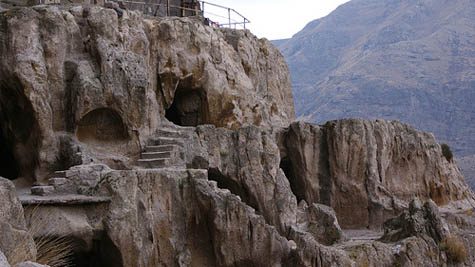
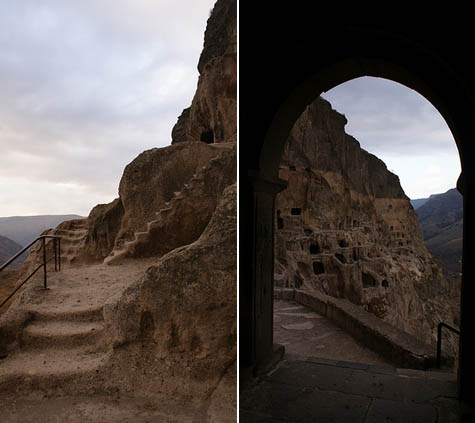
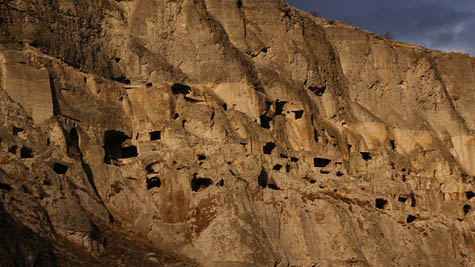 [Images: Vardzia, as seen in some stunning photos by cosh_to_jest].
[Images: Vardzia, as seen in some stunning photos by cosh_to_jest].
In any case, there’s absolutely no geological connection between Vardzia and Krubera Cave—there is no secret tunnel system linking the two across the vast Georgian landscape (after all, they are extremely far apart)—but how exciting would it be to discover that Vardzia had, in fact, been constructed as a kind of architectural filter above the stovepipe-like opening of a titanic cave system, and that, 800 years ago, monks alone in the mountains reading books about the end of the world might have sat there, surrounded by fading frescoes of saints and dragons, looking into the mouth of the abyss, perhaps even in their own local twist on millennial Christianity standing guard over something they believed to be hiding far below.
 [Images: Vardzia, via Wikipedia].
[Images: Vardzia, via Wikipedia].
In fact, I don’t mean to belabor the point here, but I’ve always been fascinated by the fact that the CIA has satellite photos that have been used as scouting documents for the rumored location of Noah’s Ark—it is “satellite archaeology,” one researcher claims. That is, there being quite a few religious members of the U.S. government, things like Noah’s Ark are considered more objective and archaeological than they are superstitious or theological.
But how absolutely mind-boggling would it be to find out someday that there is, operating within the U.S. intelligence services, a small group of especially religious analysts who have been scouring the Caucausus region, funded by tax dollars, and armed with geoscanning equipment and several miles of rope, looking for the entrance to Hell?
You can see further images of Vardzia here.
This is absolutely fascinating. 2 point:
Video games are fast approaching the time when, for all intents and purposes they will begin to look like a movie instead of games. The compute power of my computer, not even top of the line when I bought it, is more than most supercomputers from 1999. That means ten years from now, the tiny silicon (or whatever technology we move to, probably still including silicon) gods in our computers will be putting out petaflops (singles or tens of petaflops) of compute power. It's estimated we'll only need a few exaflops of compute to simulate a human mind. The human mind is a simulation of the universe, as near as we can tell at this time. So, within about 20 years, everyone will have the ability to simulate a full human mind, on their desktop. We're already working on mind/computer interfaces. Very soon, within our lifetimes, we'll be able to explore these places as if we were really there, while playing a video game. All you have to do is send one robot through with a system that can map it at human-eye level resolution and anyone can explore it. You could even have interactive robots exploring the area as your eyes and hands – the human visual cortex takes about 10Gbps to fill. And, once the full model is made, you'll only have to update changes to it so you wouldn't need a full 10Gbps network to explore the area at full visual resolution. Real video game archaeology!
The second point is simple – about the entrance to hell, which should be metaphorical but may be the literal interpretation of a volcanic crater or magma coming up in a cave by a mind from the 'biblical' times, as a volcano wasn't something from the earth but the hand of an angry god or demon.
The metaphorical entrance to hell brings up a point in and of itself in a deconstruction of the word entrance to en- and trance. The word enspell means to cast a spell on. Entrance could therefor be interpreted as to cast a trance on, even though etymologically unsound; people are spellbound by their own superstition even in the face of centuries of rationality and make the misinterpretation of trance a truth.
This post has me going from Minas Tirith to Menzoberranzan, spanning two worlds that I'm immersed in right now through reading. I've really enjoyed this series of posts on natural architectures and the places humans have created from bare rock.
Well done.
Geoff — "But how absolutely mind-boggling would it be to find out someday that there is, operating within the U.S. intelligence services, a small group of especially religious analysts who have been scouring the Caucausus region, funded by tax dollars, and armed with geoscanning equipment and several miles of rope, looking for the entrance to Hell?"
Great idea for a metaphysical spy novel.
Jeff Ford
Love these kinds of places. Thanks.
Fantastic. So wonderful to discover places like this exist. Hopefully it will be awarded World Heritage Status.
This is so like the poromechanical space in Negarestani's cyclonopedia. Cheers for the post.
Hi, I am Hans and happy to live in Georgia. Find here some images of the surroundings of the Vardzia Cave Town, especially from the village Gogasheni, which looks from above down to Vardzia in the valleay of River Mtkvari
http://picasaweb.google.com/lh/photo/P0szo8r-avgRsFJQvk436w?feat=directlink
Best regards, Hans
These mountain carved monasteries and 'spartan' apartments is common in the Caucasus region, after all most of it is covered in mountains. Here's another one, a monastery half carved into the rock cliff in Armenia dating back to 4th century.
http://en.wikipedia.org/wiki/Geghard